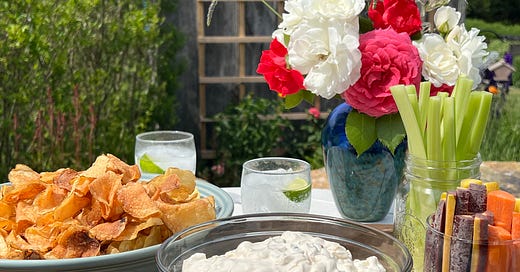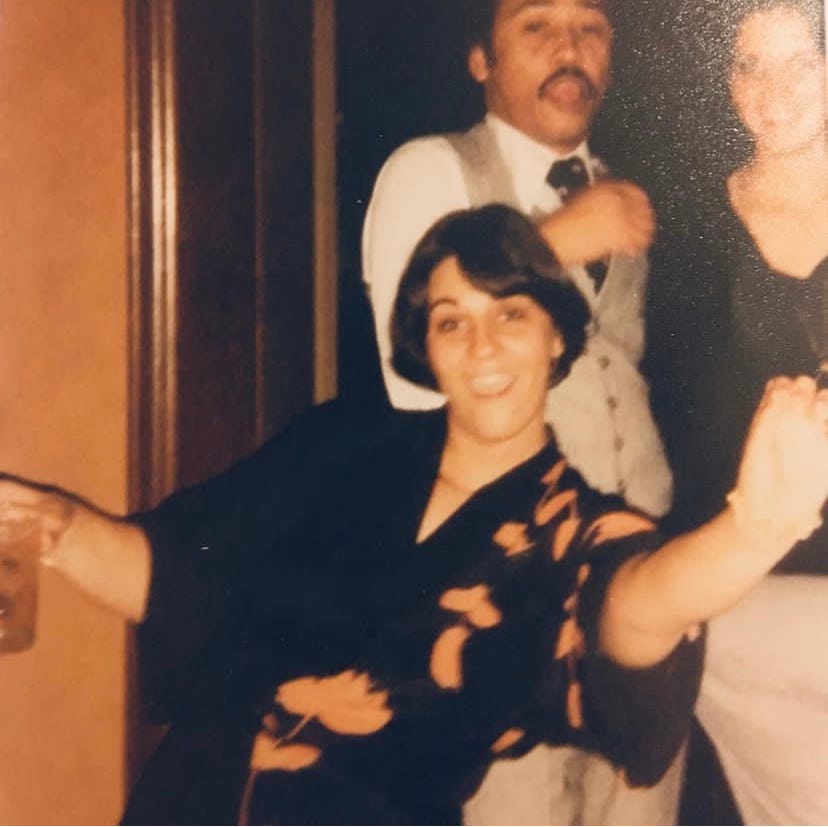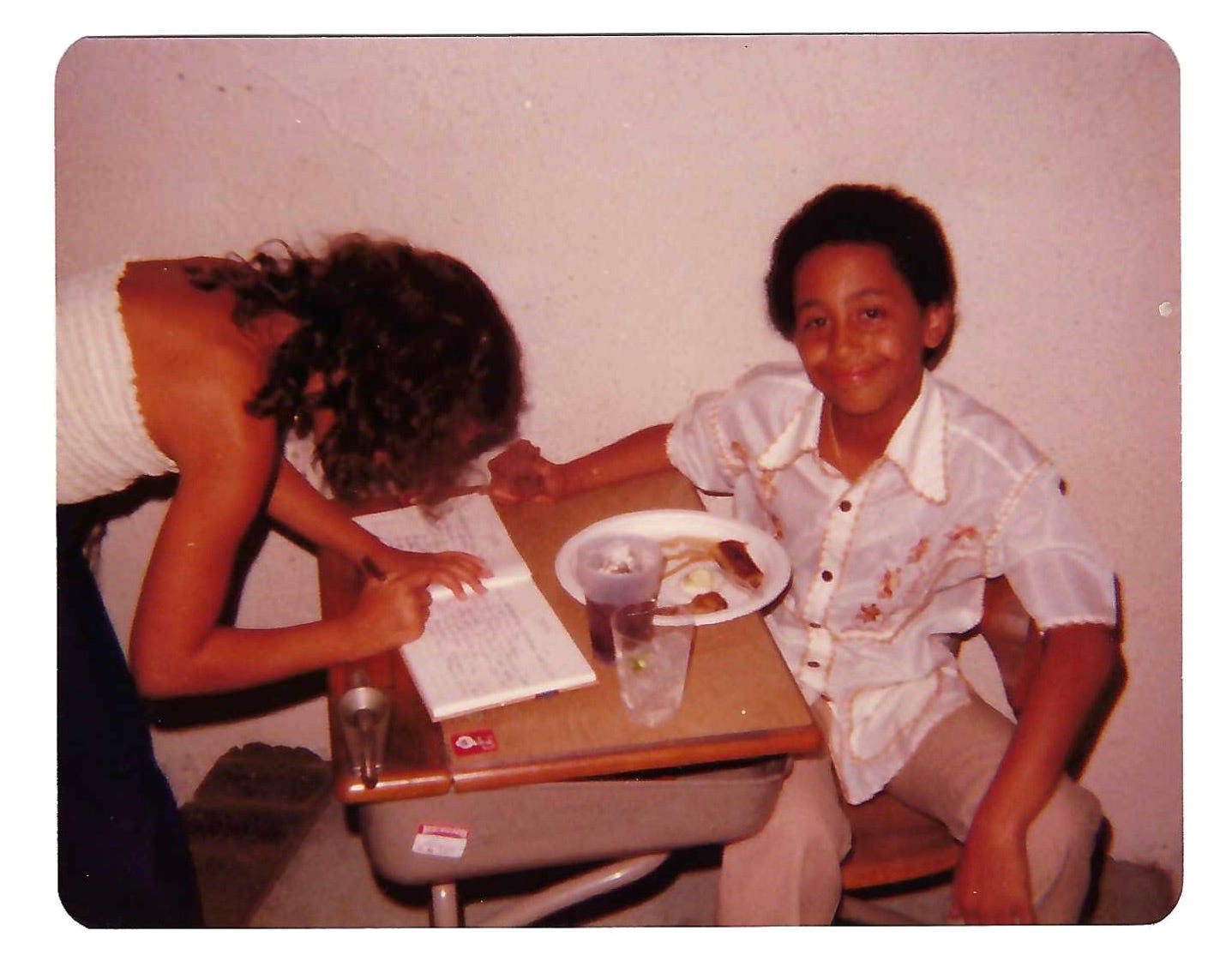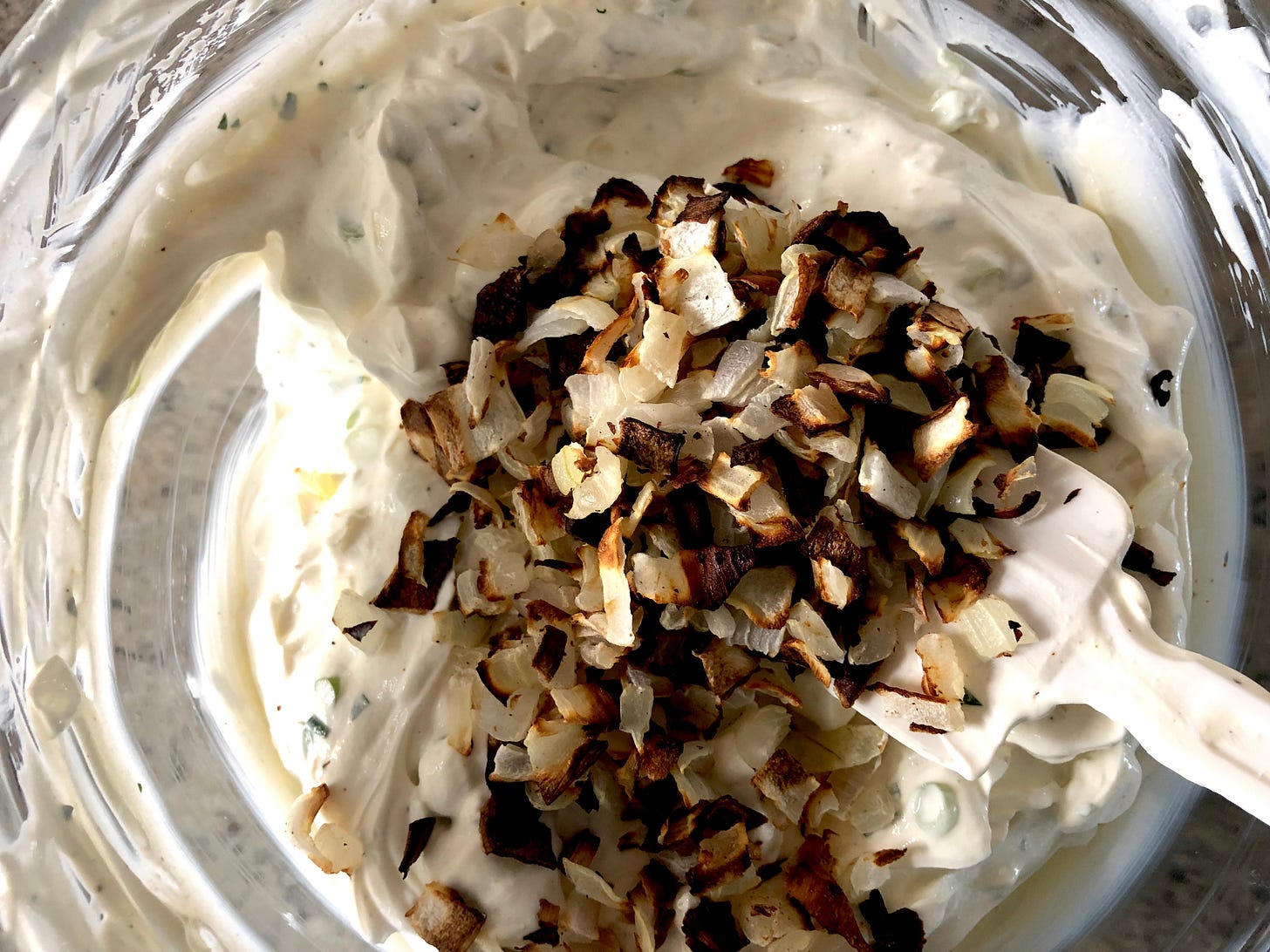Growing Up with Lumpia, Spaghetti, and Disco in "San Frangeles"
An Interview with Kato Banks of "San Frangeles"
This week, I have a special end-of-week post perfect for the start of summer. Kato Banks (aka KatoSpace), a producer (music, events, films), artist, and sometimes PR professional (mostly for friends) has been a cheerleader for the California Table concept since I started talking about it in 2020. Over the course of the last two years, Kato has told me about his multi-cultural upbringing, his parents’ massive New Year’s Eve parties, and how he became obsessed with ingredients and good cooking as a kid. (Kato’s family also has an online store dedicated to gear for outdoor entertaining, and he is working on launching an apple cider vinegar drink, inspired by shrubs, called Kiska.)
Kato also shared his popular recipe for a fresh, homemade onion dip. It’s the perfect dish for this weekend—for a Pride or Juneteenth party—or for any summer get-togethers. I have a big bowl of it in my fridge right now, and I’m going to make it a lot in the coming months! He also put together a playlist for this chips-and-dip party. It’s below, after the recipe. But first, here are our conversations, condensed and edited for clarity.
Kato Banks
I was born in Long Beach, and you could say bi-racial, but it’s more complicated than that. Even though it’s black and white, really, my dad is Filipino, and we found we have some Congolese, but before that, we were Black-Filipino and French Creole. My mom is Italian and Ukrainian. Now it’s more nuanced, because of all of these tests you can do with DNA. But on my dad’s side, his mother’s Filipino culture was very dominant, and on my mom’s side, the Italian culture is very dominant. So, really, I identify with Filipino and Italian.
My parents met in Long Beach. My dad was a Marine, my mom was a hairdresser. She did all the hair for the Playboy bunnies, for the Playboy club. She moved from Chicago with her best friend. My parents’ apartment sort of became the hub for everyone. My mom cooked for like 30 marines and their girlfriends, and everybody came over.
So, I was born into this “rainbow tribe.” It was a mix of Japanese, Mexican, Latino, Jewish—I mean, I can go on and on and on with the cultural stuff that was going on in my childhood. But I learned about and tasted all of this food.
My mom learned how to make Filipino food; my dad made her go learn for a month. My dad’s from the Bay Area, so my mom came up to Sunnyvale to learn how to make Filipino food. Everyone cooked in my family. I had the Italian side, my Italian grandfather was a cook, my Ukrainian or Polish grandmother (we’re still trying to figure that out through 23 and Me) she only made pierogis. But my grandfather was the cook, my mom is a cook, and then my dad sometimes cooked—but really it was my grandmother (his Filipino mom) that cooked—and then I had all these uncles that cooked Filipino food.
Over time our house became the hub. Eventually it got to the point where we had 200 or 300 people for New Year’s, but we didn’t have it catered. Everyone would show up for the weekend and help my mom make these dishes. On New Year’s Eve, we would have pancit, lumpia, and then we had all these people come to our house, and they would bring Japanese food and Mexican food. And we’d serve it the day of. People would come and eat the pancit, and we’d have DJs and disco and dancing. I mean, it was wild! And then the next day, my mom would have a big pot of spaghetti. So, people who didn’t come to the party would come over the next few days and eat her gravy in the big pot, with meatballs, and spaghetti. And I was the first-born in this tribe. All of this food and all of the dancing and the culture was amazing.
Not having caterers brought everyone together. We had everyone chopping the veggies. And part of it was, with most of the caterers in Orange County, the food was expensive, but it wasn’t that great. Doing it ourselves, we could control the quality, the ingredients, and the authenticity of the dishes.
When we would travel, we would go to restaurants and eat. We were food tourists. Like this was before. Now it’s everywhere. But people would be like, “Are you going to go to the tourist trap?” We were like, “Nope, sorry. We’re going to go try authentic Chinese” (because my father would want to go to Chinese). But what’s amazing about that is that I got obsessed with how foods change.
My dad went to high school in Mountain View and his parents stayed up here. Since I was four or five, my mother put us on a plane. So summers we spent here, in the Bay Area, and I was in Southern California for the rest of the year. So when people ask me where I’m from, I tell them “I’m from San Frangeles.” I’ve been telling that since I was a kid: I’m from San Frangeles.
We had a retail shop, and I went on to produce events and produce movies and produce music, and in that, with all the people I’ve met, it always included a culinary component too. I met all of these amazing people in the culinary world and tasted all this great food. I would go to fine dining, but then we’d also go to taco stands in Santa Ana, or go to LA to go to Pink’s Hot Dogs. They have the best chili dogs. And then I would go to Venice, because when I was vegan, there wasn’t very much vegan food. I’ll eat a lot of different kinds of foods, even though I prefer to eat clean food. When I’m at a taco stand, or at some truck or trying some dan dan noodles in San Gabriel Valley or over in Oakland, I don’t go, “Is this grass fed?” I just eat it.
I’ve been super hyper-focused on ingredients since I was young. I would get obsessive over things. I didn’t understand why people liked bottled dressing when I was growing up; I didn’t understand why people liked Wishbone. I remember onion dip was just so weird to me. It was those packages, and it wasn’t good. And my mom made homemade meals, and she rarely used cans. I would go to people’s homes, and they would have Stouffer’s, or they would have Hamburger Helper. All that stuff was just so exotic to me. But real food wasn’t.
I started reading ingredients really young. I did what I called whole art installations of ingredients. So I decided to take ingredients off the labels and put them on artwork. I was obsessed with ingredients. And then I started seeing things change from the ‘70s and through the 80s. Dressings were just disgusting out of the bottle. Thousand Island, I was just like, What is this goop? Where does it come from? Because I remember eating Thousand Island at the steakhouses in the early ‘70s as a kid, and I remember it was so good. Everyone also loved the Lipton soup onion dip, and I couldn’t stand it. And it was everywhere. It’s not that it’s not good. I get why Lipton onion dip is such a popular thing, because it’s so easy to make. Especially in the ‘70s.
So I started getting obsessed with going to garage sales and finding old versions of The Joy of Cooking. I also would pick up old social books and church books with all these recipes from all the women. I was on this mission to find out What was the original Thousand Island? And it turns out, when you make it from scratch with, like, the eggs and the olives, fresh parsley, and onions, it is like it was in the old days, then you go, This is why Thousand Island was amazing!
As a kid I didn’t like margarine. And I was never a sugar person. I was the kid at the birthday party who didn’t like cake. It was always too sweet. And I didn’t like the frosting. But then my mother had this old cookbook from her great-grandmother, and I read a real cake recipes, like with real buttercream and real cake, and I was like Oh, this actually isn’t too bad for you! It was an old cookbook that all the housewives used. It was falling apart, and it was browned on the pages. It was probably from the late 1800s or early 1900s. So I started baking, because I wanted to control the ingredients. I was six or seven.
My obsession with the simplicity of hating cake and then making a real one with buttercream and using real ingredients, and that not hurting my stomach, that carries over to today. When I cook at home, I like to use something simple. I use just olive oil, good butter, sometimes I use sesame, and then I’ve always liked clean salts. I’ve never liked Morton’s salt. I’ve always used sea salts. It’s the craziest thing. I was young and used sea salt. Growing up in the late 70s and 80s, you could only find this stuff in gourmet stores. They were like only rich people shopped there. And we were upper-middle class, but we weren’t people who could just buy a twenty-dollar salt, or whatever it cost. But I still liked it and I’d find it.
I’m so obsessed with ingredients that in high school, I did paintings of ingredients, and I put them up. I’d throw parties at my house, and I’d turn my garage into a gallery, and I had my paintings of ingredients. Even when I would eat a McDonald’s cheeseburger, I knew what was in it. I knew what chemicals. I always liked good bread. I never liked Wonderbread because it would stick to your mouth. And I would read the ingredients, and it would have have 30 ingredients, and I’m thinking yeah, but good bread only has three or four. People don’t know what they’re eating. They just don’t. And sometimes people have reactions to it. Now people know more about it.
But I was always obsessed with ingredients. When I’m cooking at home or entertaining, my style is all about ingredients. I don’t like a lot of different oils. I’ve always liked good olive oil. I’ve always liked butter. I pretty much cook seasonally. Luckily, we have a bounty here. On a daily basis, my cooking is really simple. It’s always a simple clean steak from Marina Meats or a fresh cut of a fish, or sometimes I’ll do the Llano Seco pork and make a quick pork chop and sauté it up with garlic and Brussels sprouts and fresh herbs and things like that. Or just whip up a salad.
I usually start my day with celery juice and a version of my bulletproof coffee—I use hemp and olive oil and cinnamon and mushrooms in this kind of concoction of a bulletproof coffee. I don’t like to do butter every day. A lot of times my eggs are just simple. I’ve developed this really great recipe to get rid of celery where you cut a bunch of celery and butter and onions. It’s filled with celery, and I do that with eggs. It’s all about simplicity.
A lot of my cooking has to do with using what’s in your refrigerator. So, I’ll go to the farmers’ market, and I’ll buy something on a Saturday, but because of my obsession with ingredients, I can literally look into any refrigerator or any pantry and just come up with something to whip up. Knowing what’s in certain things—what’s in an aioli or a tartar sauce, or how to make a fried chicken—when you put all of these things together, you can make variations on anything. If you don’t want to make fried chicken or a fried chicken salad, there are different ways you can whip it up with whatever’s in the refrigerator or the pantry.
What I learned from my mother, is that I can go anywhere and taste a dish—if I’m at your house, and I taste a dish, I can go recreate it at home. If I’m at a restaurant. Sometimes it takes me a couple times, but the minute I taste it, it’s in my head.
Now when I’m entertaining, I like a challenge, and I will go for a Julia Child recipe that takes three days, or I’ll pull out one of my mom’s recipes from my Italian side. I can only do a little Filipino cooking. I was always a little bit intimidated by it. So, I know how to whip up some Filipino food, but I don’t have the recipes from my grandmother. I have made lumpia and stuff. But the simplicity of what my Filipino grandmother could make really influenced me. She could take one tomato, and one pork chop, and mix it with potatoes and like a stock, and make this stew that we could put over rice. And I do know how to do that.
Italian cooking was really easy for me to pick up. My family is from Puglia—Sicily and Puglia—but I started reading about all the other regions. Most of it was Italian food brought over from my great-grandfather and great-grandmother from Italy. So those recipes were passed down. Then I have a godmother who’s Italian and has all these amazing dishes from her region. I think she’s Calabrian. We didn’t really do Italian-American food. We did more of the dishes that were brought over from Italy.
I tend to play with the recipes, but there are a few things where I tend to stick to the old school version, like Bolognese. I don’t make the pasta anymore. My great-grandmother made the pasta. They’d make everything. I think they would go to the butcher and have them make their sausages a certain way, and things like that.
When I’m entertaining, I like to put a menu together. If it’s summer, I always like to do fresh oysters (but that’s not cooking). I also get into this whole thing—getting back to the onion dip, it’s so weird that I’m bringing this up—but my family always wants me to make this onion dip.
I take fresh onions, I take green onions, and I take, I take white onions, yellow onions, and green onions, and I toast the yellow onions, I chop up the white onion, I chop up the green onion, and I whip it up with some lemon juice and some sour cream, and then there’s some other things that I add to it. But it’s so simple. And I mimic sort of that onion dip that I hated so much, but I make it fresh. And they always request it. I take good, full-fat sour cream (sometimes I use Nancy’s which has probiotics in it) and I try to elevate it and make it something that’s considered a treat, and make it, like, healthier.
It used to be that we’d make homemade potato chips that would take a long time, but now you have so many great potato chips that you can buy healthier versions of them made with olive oil or avocado oil. So that is something that I make on a regular basis. And it cracks me up, because there’s all these other things that I can make, and that’s what they request in the summer months.
Homemade Onion Dip
When Kato and I started talking about what recipe to run with his interview, he told me that, while he has all kinds of elaborate recipes (including things like spaghetti with fresh uni from Stephanie Mutz), this was the dish people always ask him to make. It’s his clean version of the chemical-filled onion dips of his childhood, and in many ways I think it really reflects his approach to cooking and how it is informed by an obsession with quality ingredients.
This recipe is huge and is meant to serve a big party. (The photo at the top of the post shows only half of the total dip.) But Kato warned me that every time he makes it, it disappears fast. Having tried it, I can see why! It’s also great with vegetables, if you want more things to dip.
1 medium yellow onion, diced
2 cups finely chopped white onion
1 cup green onion thinly cut crosswise
2 tablespoons finely chopped flat-leaf parsley
2 ½ teaspoons of Bragg’s liquid aminos (or soy sauce)
1 ½ teaspoons fresh ground black pepper
1 ½ teaspoons sea salt or Himalayan pink salt
1 teaspoon Worcestershire sauce
1 teaspoon of freshly squeezed lemon juice
½ teaspoon of granulated garlic
Preheat the oven 450°F. Line two cookie sheets with foil and spread the chopped yellow onion out on the sheets, leaving lots of room between the pieces. Toast the onion until browned (but not burnt), about 25 minutes. (The pieces of onion will range from lightly golden to dark brown. About half the pieces should be crisp.)
Put the sour cream in a large bowl and mix in the toasted onion (scraping and pulling the browned bits off of the foil) and all of the remaining ingredients.
Cover the bowl with plastic wrap and refrigerate overnight.
Before serving, give the dip a good mix; the toasted onion will have softened, and you’ll want to make sure its flavor is evenly distributed.
A Chips-and-Dip Party Playlist
Kato also created a playlist to go with the dip recipe: Chips & Dip Party Pairing The playlist is arranged in no particular order and is fun to play on shuffle. As Kato told me:
I’m working on getting this launched. It’s called TasteTone, and it’s culinary-music pairings. Because, really, it’s the taste and then the tone. And they kind of go back and forth. I found that music, food, and coming together are common themes throughout my life. It’s all about bringing people together. We live in a world where there’s a lot of horrible things, but the food, the music, the taste, the bringing together joy is important.
Photos: Georgia Freedman, Courtesy of Kato Banks (6), Georgia Freedman, Courtesy of Kato Banks, Georgia Freedman













Curious. How did you make your homemade potato chips?